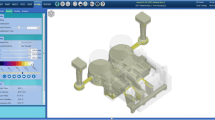Summary
A comprehensive computer-aided-design system for producing castings must make use of several techniques to model the flow of molten metal through the sprue and runners and into the mold cavity. The techniques described in this report have proven to be useful, each in its own place. The techniques based on the Bernoulli and Saint-Venant equations are well established, but it is important to incorporate them in a computer system so that the mass of calculations required to obtain solutions, often iteratively, may be handled with ease, and so that the extensive data bases that are needed may be accessed efficiently. The marker-and-cell technique, although not previously used to any extent in metallurgical applications, appears to have a unique ability to model flow patterns within mold cavities. Taken together, these techniques can provide the designer with the information needed to improve casting quality and efficiency.
Similar content being viewed by others
References
G. H. Geiger and D. R. Poirier, Transport Phenomena in Metallurgy, Chapters 3–4, Wesley, New York, New York, 1973.
L. F. Moody, “Friction Factors for Pipe Flow,” Transactions of ASME, 66 (1944), pp. 671–684.
L. F. Moody, “An Approximate Formula for Pipe Friction Factors,” Mechanical Engineering, 66 (1947), pp. 1005–1006.
S. I. Karsay, Ductile Iron III, Gating and Risering, Fer et Titane Inc., Sorel, Quebec, 1980.
R. W. Ruddle, The Running and Gating of Sand Castings, The Institute of Metals, Grosvenor Gardens, London, 1956, pp. 165–172.
F. E. Giesecke and W. H. Badgett, “Supplementary Friction Heads in One-Inch Cast-Iron Tees,” Heating, Piping, and Air Conditioning, 4 (1932), pp. 53–56.
D. H. St. John, K. G. Davis, and J. G. Magny, “Computer Modelling and Testing of Metal Flow in Gating Systems,” CANMET, Energy, Mines, and Resources Canada; Internal Report MRP/PMRL 80-12(J), 1980.
F. H. Harlow and J. E. Welch, “Numerical Calculation of Time-Dependent, Viscous, Incompressible Flow of Fluids with Free Surface,” The Physics of Fluids, 8(12) (1965), pp. 2182–2189.
J. E. Welch, F. H. Harlow, J. P. Shannon, and B. T. Dally, “The MAC Method — A Computing Technique for Solving Viscous, Incompressible, Transient Fluid-Flow Problems Involving Free Surfaces,” Los Alamos Scientific Laboratory Report, LA-3425, 1965.
C. W. Hirt, “Heuristic Stability Theory for Finite Difference Equations,” Journal of Computational Physics, 2 (1970), pp. 339–355.
“Water Analogy Studies — Flow and Gating of Castings,” film produced by Case Institute of Technology for American Foundrymen’s Society Training and Research Institute, Des Plaines, Illinois, and Die Casting Research Foundation, Inc., New York, New York.
M. C. Ashton and R. K. Buhr, “Direct Observation of the Flow of Molten Steel in Sand Molds,” CANMET, Energy, Mines and Resources Canada; Internal Report PM-M-73-5, 1973.
Rights and permissions
About this article
Cite this article
Hwang, WS., Stoehr, R.A. Fluid Flow Modeling for Computer-Aided Design of Castings. JOM 35, 22–29 (1983). https://doi.org/10.1007/BF03338386
Published:
Issue Date:
DOI: https://doi.org/10.1007/BF03338386




